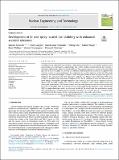| dc.contributor.author | Champagne, Victor | |
| dc.contributor.author | Sevecek, Martin | |
| dc.contributor.author | Gurgen, Anil | |
| dc.contributor.author | Seshadri, Arunkumar | |
| dc.contributor.author | Che, Yifeng | |
| dc.contributor.author | Wagih, Malik M. | |
| dc.contributor.author | Phillips, Bren Andrew | |
| dc.contributor.author | Shirvan, Koroush | |
| dc.date.accessioned | 2018-07-26T13:28:11Z | |
| dc.date.available | 2018-07-26T13:28:11Z | |
| dc.date.issued | 2018-01 | |
| dc.date.submitted | 2017-12 | |
| dc.identifier.issn | 1738-5733 | |
| dc.identifier.uri | http://hdl.handle.net/1721.1/117129 | |
| dc.description.abstract | Accident-tolerant fuels (ATFs) are currently of high interest to researchers in the nuclear industry and in governmental and international organizations. One widely studied accident-tolerant fuel concept is multilayer cladding (also known as coated cladding). This concept is based on a traditional Zr-based alloy (Zircaloy-4, M5, E110, ZIRLO etc.) serving as a substrate. Different protective materials are applied to the substrate surface by various techniques, thus enhancing the accident tolerance of the fuel. This study focuses on the results of testing of Zircaloy-4 coated with pure chromium metal using the cold spray (CS) technique. In comparison with other deposition methods, e.g., Physical vapor deposition (PVD), laser coating, or Chemical vapor deposition techniques (CVD), the CS technique is more cost efficient due to lower energy consumption and high deposition rates, making it more suitable for industry-scale production. The Cr-coated samples were tested at different conditions (500°C steam, 1200°C steam, and Pressurized water reactor (PWR) pressurization test) and were precharacterized and postcharacterized by various techniques, such as scanning electron microscopy, Energy-dispersive X-ray spectroscopy (EDX), or nanoindentation; results are discussed. Results of the steady-state fuel performance simulations using the Bison code predicted the concept's feasibility. It is concluded that CS Cr coating has high potential benefits but requires further optimization and out-of-pile and in-pile testing. | en_US |
| dc.description.sponsorship | United States. Department of Energy (Grant DE-NE0008416) | en_US |
| dc.publisher | Elsevier | en_US |
| dc.relation.isversionof | http://dx.doi.org/10.1016/J.NET.2017.12.011 | en_US |
| dc.rights | Creative Commons Attribution-NonCommercial-NoDerivs License | en_US |
| dc.rights.uri | http://creativecommons.org/licenses/by-nc-nd/4.0/ | en_US |
| dc.source | Elsevier | en_US |
| dc.title | Development of Cr cold spray–coated fuel cladding with enhanced accident tolerance | en_US |
| dc.type | Article | en_US |
| dc.identifier.citation | Ševeček, Martin et al. “Development of Cr Cold Spray–coated Fuel Cladding with Enhanced Accident Tolerance.” Nuclear Engineering and Technology 50, 2 (March 2018): 229–236 © 2018 Elsevier | en_US |
| dc.contributor.department | Massachusetts Institute of Technology. Department of Nuclear Science and Engineering | en_US |
| dc.contributor.mitauthor | Sevecek, Martin | |
| dc.contributor.mitauthor | Gurgen, Anil | |
| dc.contributor.mitauthor | Seshadri, Arunkumar | |
| dc.contributor.mitauthor | Che, Yifeng | |
| dc.contributor.mitauthor | Wagih, Malik M. | |
| dc.contributor.mitauthor | Phillips, Bren Andrew | |
| dc.contributor.mitauthor | Shirvan, Koroush | |
| dc.relation.journal | Nuclear Engineering and Technology | en_US |
| dc.eprint.version | Final published version | en_US |
| dc.type.uri | http://purl.org/eprint/type/JournalArticle | en_US |
| eprint.status | http://purl.org/eprint/status/PeerReviewed | en_US |
| dc.date.updated | 2018-07-20T11:12:48Z | |
| dspace.orderedauthors | Ševeček, Martin; Gurgen, Anil; Seshadri, Arunkumar; Che, Yifeng; Wagih, Malik; Phillips, Bren; Champagne, Victor; Shirvan, Koroush | en_US |
| dspace.embargo.terms | N | en_US |
| dc.identifier.orcid | https://orcid.org/0000-0002-5191-1774 | |
| dc.identifier.orcid | https://orcid.org/0000-0003-1388-3810 | |
| dc.identifier.orcid | https://orcid.org/0000-0003-1841-9937 | |
| dc.identifier.orcid | https://orcid.org/0000-0003-3352-329X | |
| dc.identifier.orcid | https://orcid.org/0000-0002-8115-5981 | |
| mit.license | PUBLISHER_CC | en_US |
